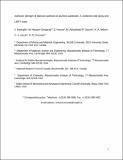Adhesion strength of titanium particles to alumina substrates: A combined cold spray and LIPIT study
Author(s)
Imbriglio, SI; Hassani-Gangaraj, M; Veysset, D; Aghasibeig, M; Gauvin, R; Nelson, KA; Schuh, CA; Chromik, RR; ... Show more Show less
DownloadAccepted version (1.156Mb)
Publisher with Creative Commons License
Publisher with Creative Commons License
Creative Commons Attribution
Terms of use
Metadata
Show full item recordAbstract
© 2019 The cold spray process and laser-induced projectile impact test (LIPIT) are used to deposit Ti powder particles on sintered polycrystalline Al 2 O 3 . Whereas LIPIT allows real-time observations of single particle impact and measurement of particle impact velocity, cold spray rapidly and simultaneously deposits particles with a wide range of deposition velocities and sizes. By use of these two techniques, the effect of particle velocity and substrate morphology on adhesion strength of single splats is investigated. The critical velocity for deposition is identified to be approximately 580 m/s for the Ti/Al 2 O 3 system when using LIPIT and particles of 10 μm. Above the critical velocity, flattening ratio (FR) is also evaluated and observed to be linearly dependent on the particle impact velocity. Splat adhesion testing is performed on LIPIT-deposited as well as on cold spray-deposited powder particles to measure adhesion strength. This analysis shows that adhesion strength is highly affected by local substrate surface morphology, where particles bond more weakly to relatively smooth portions of the substrate. Therefore, mechanical bonding plays a significant role in adhesion. Also, adhesion strength decreases with an increase in FR and therefore velocity. This decrease can be associated with fracture of the ceramic substrate and rebound forces.
Date issued
2019Department
Massachusetts Institute of Technology. Department of Materials Science and Engineering; Massachusetts Institute of Technology. Institute for Soldier Nanotechnologies; Massachusetts Institute of Technology. Department of ChemistryJournal
Surface and Coatings Technology
Publisher
Elsevier BV